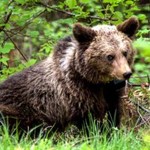Photograph: Ben Birchall/PA - theguardian.com - Mon 24 Jan 2022
'Highly predatory’ animals emerge from hibernation and move to areas with reindeer and moose calves, finds study
Brown bears switch habitats in the spring so they can hunt reindeer and moose calves, research suggests.
After emerging from hibernation, the animals embark on an active hunting strategy to take full advantage of the calving period.
One of the bears studied killed 38 newborn reindeer in one month and 18 young moose the next.
Research involving conservation experts at Nottingham Trent University, the University of León in Spain and Norwegian and Swedish researchers found the animals adapted their home ranges and used the landscape to mirror the habitats of vulnerable prey.
Fifteen bears were fitted with GPS collars and monitored for two years in Norrbotten, northern Sweden, and more than 2,500 adult female reindeer were also tracked in order to alert researchers to close encounters.
The study found that bears surfaced from six-month hibernation in the spring, which was when the reindeer calving period started.
At this time they changed their preference for habitats close to wetlands and evergreen forests to more rugged terrain and higher elevations favoured by reindeer with young.
After the reindeer calving period ended and the moose calving season started, the predators started to move to areas preferred by the latter – closer to deciduous forests and old clear cuts.
But in the summer, once calving season ended and human activity became more common, the bears switched to a diet of berries and moved well away from gravel roads until it was time to hibernate again.
Dr Antonio Uzal Fernandez, an expert in wildlife conservation in Nottingham Trent University’s School of Animal, Rural and Environmental Sciences, said: “It is clear that highly predatory bears were mirroring the land cover types of reindeer and moose to overlap with seasonally available and vulnerable prey. Such a process shows an active hunting strategy of brown bears in spring, when their diet is more dependent on animal protein than during the rest of the year.
“Large carnivores are partially recovering their former ranges across multiple continents, and while this can provide ecological benefits for many ecosystems, it can also bring management implications and undesired effects such as depredation of livestock.”
He added: “Our work could help to inform managers and livestock owners how to reduce this conflict and promote long-term conservation and human-wildlife coexistence. Interestingly, high and low predatory bears selected habitats differently in all study periods, with few habitats selected or avoided by both groups.”
According to the study, kills peaked during the reindeer calving periods in May. Eight of the 15 bears were classed as highly predatory and averaged about half a kill a day during the reindeer and moose-calving periods.
The predators killed more than 20 newborn reindeer and five newborn moose in a calving period, the study showed, with one bear averaging about three kills every two days.
The researchers say their findings, published in the journal Diversity, could help develop forecasts of potential hotspots and conflict and establish possible preventive actions.




